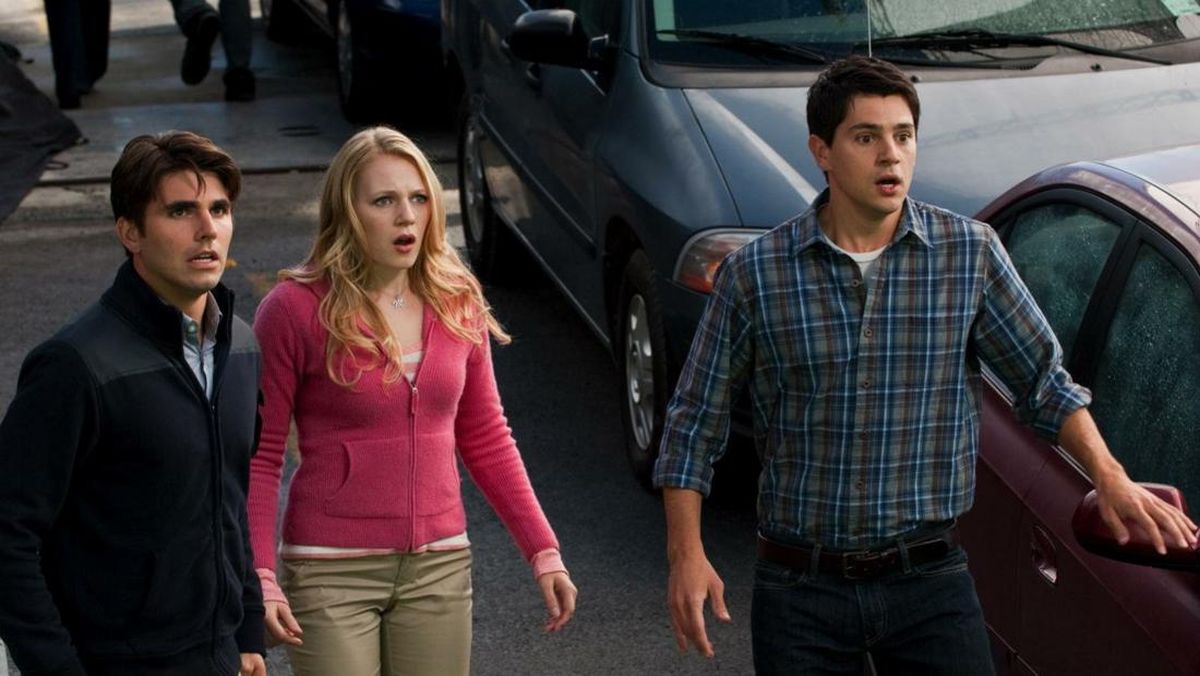October 27, 2025 — 2:36pm
I did not have to do much to convince my grandma to join me in a dark, cavernous room on the backstreets of New Orleans. Back in the day, Grandma was in a marching band – she was a drummer, walking in the front line in tandem with the bang of her instrument. Heading to NOLA for a whirlwind musical adventure was never a hard sell.
In fact, it started as an offhand comment, after I told her about my trip to the area in 2019, when I found myself deeply enamoured with the drum and thrum of the Bayou city. I told her about the tiny hole-in-the-walls where I watched men tango with their trumpets and sway with their saxophones, tripping the light fantastic for an hour on a weeknight.
She wanted in. Then a pandemic saw the world shut down. Then it opened up again, and our trip down south was top of the agenda.
The hole-in-the-wall that stole my heart most of all on that trip was Preservation Hall, where my friend Ed and I lined up with cash clutched in our sweaty hands in the hopes of watching the Preservation Hall All Stars Band make magic in a 20-foot-by-30-foot wood-walled room (about 55 square metres). Before the sun went down, we ferreted away to sit on the floor and listen to riffs and improvisation of the most incredible quality, produced by a tag-team of superstars. I was electrified, and Grandma was the first to know.
Preservation Hall is a ramshackle wooden hall off Bourbon Street that has hosted musicians since 1961. It’s home to 60 different New Orleans-based musicians, who range in age from their mid-20s to 90s. Post-pandemic there’s no line-up, and shows are booked online in advance.
After years of being separated by land and sea – me in Sydney, my grandmother in Illinois – we fly down from the Midwest and settle in for two nights – in a row – of NOLA’s living history.
Much of the beauty of Preservation Hall is in the way musicians are involved with the organisation. Founded by Allan and Sandra Jaffe in the 1960s, PH quickly came to represent the power of the collective preservation of local music and musicians, and supported the growth, spread and conservation of the musical style and its creators.
There’s no formal application process to be involved; many artists come from family lines of PH players. These days, PH also runs the Preservation Hall Foundation, which endeavours to “protect, preserve and perpetuate New Orleans music and culture”.
The space itself is straightforward – folksy, even. Benches are unbacked, and your ticket might mean you have to stand for the 45-minute show. But the enrapturing performance put on by the musicians – some of whom are students or relatives of elder PH musicians, but some of whom just frequented the hall and then found themselves asked to sit in and jam – means you don’t even notice.
The joyful ease with which the musicians interact – chatting among themselves, improvising and giggling – makes the audience quickly feel like flies on the wall, let into a groove session between old friends, where bouncing riffs play against stupendous licks.
Louis Ford is on the clarinet during our second visit. For a handful of songs, the multi-instrumentalist, educator and curriculum developer for the Preservation Hall Lessons (who also happens to be from a long line of musicians, including many who played at PH themselves) picks up the sax and belts out tunes so sweet that they could sit atop a pancake.
He plays alongside Rickie Monie (keys) and Branden Lewis (trumpet), among others, and raises his hand in a subtle, cheeky wave at the end of each solo. All the cats on that stage – facing us in run-of-the-mill wooden chairs, grinning at each other – create syrupy, sticky music that doesn’t so much creep into your bones as electrocute, heating us from the inside out. How can any of us hold it in?
The city hasn’t, after all. The music now known as jazz, while itself rich with an at times dark and violent history, started in New Orleans, and its international success belongs to this city.
Here it started, and here it grew into the rhythm that created and sustained musicians including Buddy Bolden, Jelly Roll Morton, Louis Armstrong, Sidney Bechet and Fats Domino.
They’re all immortalised at the New Orleans Jazz Museum, inside the Old US Mint down past the French Market. Across three levels, the museum showcases what makes the Crescent City so special in the music world, and how jazz could only ever have come from here. Drum kits from the city’s great trailblazers sit alongside the history of Second Lines and brass-band parades. (For further reading, consider Gary Krist’s Empire of Sin, which dives into “the battle for modern New Orleans”, with jazz at the forefront.)
Then there’s Frenchmans Street, pulsing as it is with tiny hideaway bars and music rooms and beats that squeal into the early morning. But the beauty of music in this city is that it’s everywhere, and everyone knows the beat.
Spontaneous bands pop up in Jackson Square, the stylistic heart of the French Quarter, with sticker-covered tubas and bucket drums, a throwback to the spasm bands of the city’s early years. Musicians busk for hours, singing tunes that rattle on portable speakers, tapping their feet to their own time; locals and tourists alike gravitate towards the tunes, hungry for the otherworldly reinvigoration only possible by a combination of this music and its unique presentation by these New Orleans musicians. It seeps into you, warms you up, sets you alight.
My grandma hops along with the music everywhere we go, pausing in the pedestrian-first streets to tap along to an 11-year-old on her portable drum or a 58-year-old with his saxophone hanging from his neck. In the heavy Louisiana heat, beads of sweat run down the foreheads of musicians and audiences equally, both enchanted by the dizzying living history of this world-changing music. Every time we leave after a set, Grandma’s twinge of regret is apparent; “one more song” could very accurately be the city’s tagline. It certainly became our modus operandi.
By the time we leave New Orleans, we begin to feel it in our bones, the rhythmic ache of a city that – still, now – tells its triumphs and tragedies through music. We can hear it in the laughing buskers and the thrum of the streetcar clicking down Canal Street. In a city that’s been battered time and again, by circumstance and struggle, the streets still sing. The beat, of course, must go on.
FIVE MORE THINGS IN NEW ORLEANS
Gobble beignets with a tune
These sweet, doughy treats are a quintessential part of a visit to New Orleans. Take a seat at the Cafe du Monde on the edge of Jackson Square and listen to talented street musicians while licking powdered sugar off your fingers and sipping on smokey chicory-laced coffee. Packed tables move quickly, so be patient. See shop.cafedumonde.com
Take a cooking class
The suburban space known as the Southern Food and Beverage Museum is part-museum and part-activity space, with a winding floorplan that takes you through exhibits of whisks, kitchen doohickeys and Louisiana’s culinary contributions, before finishing at a cooking space where you can take classes in jambalaya or Creole essentials. Set aside the afternoon. See southernfood.org
Taste summer in a sandwich
It’s counter service only at epic eatery Turkey and The Wolf, deemed to be one of America’s best. The menu is unfussy and mindblowingly flavourful; over the summer, pair a tomato sandwich with a wedge salad that comes out drenched in blue cheese dressing and sprinkled with crunchy bacon bits and everything bagel seasoning. Messy and marvelous. See turkeyandthewolf.com
Pick up only-in-NOLA postcards
The cards, prints and postcards at Lionheart Prints, a woman-owned Magazine Street shopfront, are all hand-lettered and produced on an original Heidelberg press. NOLA pride is strong here, and it’s the perfect place to pick up stationery stamped with trumpets, oysters or a fleur-de-lis. See lionheartprints.com
Tour the city’s cemeteries
Because the city sits at about (or below) sea level, its ornate and macabre cemeteries are home to tombs that spend eternity, well, above ground. A cemetery tour – such as one exploring the city’s famous Lafayette and Saint Louis cemeteries – and the likes of the tomb of the Voodoo Queen, Marie Laveau – is a great way to understand NOLA’s cultural dynamics and diverse history. See cemeterytourneworleans.com
The details
Visit
Preservation Hall shows run multiple times most evenings, with tickets starting at $US25 ($37) for standing room. Buy ahead online – cash is no longer accepted at the door. See preservationhall.com
Stay
In the Warehouse District, Barnett Hotel (thebarnett.com, rooms from $US187/$285) is moody and funky – in keeping with NOLA’s creative heart.
In the French Quarter, Four Points by Sheraton (marriott.com, from $US150/$225) has rooms with balconies over the bustling streets below.
Eat
Cafe du Monde has multiple locations, but the Jackson Square-adjacent spot is regularly serenaded by street artists. See shop.cafedumonde.com
Museum
The New Orleans Jazz Museum is at 400 Esplanade Avenue, open most days 9am to 4pm, entry is $US11 for adults. See nolajazzmuseum.org/visit
Fly
From Australia, Dallas Fort Worth is the easiest connection point to fly onwards to Louisiana’s Louis Armstrong New Orleans International Airport. See flymsy.com
The writer travelled at her own expense.
Sign up for the Traveller Deals newsletter
Get exclusive travel deals delivered straight to your inbox. Sign up now.
Riley Wilson is a freelance journalist and editor specialising in travel, food, architecture and agriculture. She is a former desk editor at The Sydney Morning Herald and The Age, and the creator of the Greater Good newsletter.Connect via email.



















































